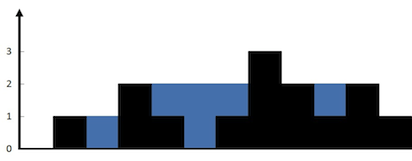[LeetCode] 岛屿数量问题(Number of Islands)
By Long Luo
200. 岛屿数量
BFS
1 | public static int numIslands_bfs(char[][] grid) { |
DFS
1 | class Solution { |
By Long Luo
1 | public static int numIslands_bfs(char[][] grid) { |
1 | class Solution { |
By Long Luo
252. 会议室 253. 会议室 II
2402. 会议室 III
1 | public static boolean canAttendMeetings_bf(int[][] intervals) { |
1 | public static boolean canAttendMeetings(int[][] intervals) { |
By Long Luo
This article is the solution 4 Approaches: Two Pointers, Sorting, Priority Queue and Binary Search of Problem 658. Find K Closest Elements .
Here shows 4 Approaches to slove this problem: Two Pointers, Sorting, Priority Queue and Binary Search with Two Pointers.
1 | // TP time: O(n) space: O(1) |
By Long Luo
This article is the solution 3 Approaches: Brute Force, Stack, Slow Fast Pointers with Animation of Problem 19. Remove Nth Node From End of List .
Here shows 3 Approaches to slove this problem: Brute Force, Stack, Slow Fast Pointers.
It’s easy to think of the way that we traverse the linked list first, from the head node to the end node, to get the length of the linked list \(L\).
Then we traverse the linked list from the head node again. When the \(L-n+1\) th node is traversed, it is the node we need to delete.
We can traverse \(L-n+1\) nodes starting from the dummy node. When traversing to the \(L-n+1\)th node, its next node is the node we need to delete, so we only need to modify the pointer once to complete the deletion operation.1
2
3
4
5
6
7
8
9
10
11
12
13
14
15
16
17
18
19
20
21
22
23
24
25
26public static ListNode removeNthFromEnd(ListNode head, int n) {
if (head.next == null && n == 1) {
return null;
}
List<ListNode> nodeList = new ArrayList<>();
ListNode pNode = head;
int size = 0;
while (pNode != null) {
nodeList.add(pNode);
size++;
pNode = pNode.next;
}
if (n == size) {
return head.next;
} else if (n == 1) {
pNode = nodeList.get(size - 2);
pNode.next = null;
} else {
pNode = nodeList.get(size - n - 1);
pNode.next = pNode.next.next;
}
return head;
}
By Long Luo
This article is the solution From Brute Force to DP to Two Pointers with Detail Explaination of Problem 42. Trapping Rain Water .

It’s like Leetcode 11. Container With Most Water , we can consider the black block as a wall, the blue block as water. Given an array, each element represents the height of the wall from left to right, find out how many units of water can be held.
The solution can be refered 2 Approaches: BF and Two Pointers with Image Explaination .
It’s easy to use the brute force approach. The time complexity is \(O(max^n)\) , so it will TLE.1
2
3
4
5
6
7
8
9
10
11
12
13
14
15
16
17
18
19
20
21
22
23
24
25
26
27
28
29
30
31
32
33// Row time: O(max * n) space: O(1)
// TLE
public static int trap_row(int[] height) {
if (height == null || height.length <= 2) {
return 0;
}
int ans = 0;
int len = height.length;
int maxHeight = 0;
for (int x : height) {
maxHeight = Math.max(maxHeight, x);
}
for (int i = 1; i <= maxHeight; i++) {
boolean flag = false;
int water = 0;
for (int j = 0; j < len; j++) {
if (flag && height[j] < i) {
water++;
}
if (height[j] >= i) {
ans += water;
water = 0;
flag = true;
}
}
}
return ans;
}